情态动词加完成时
不定式完成式to have done用法
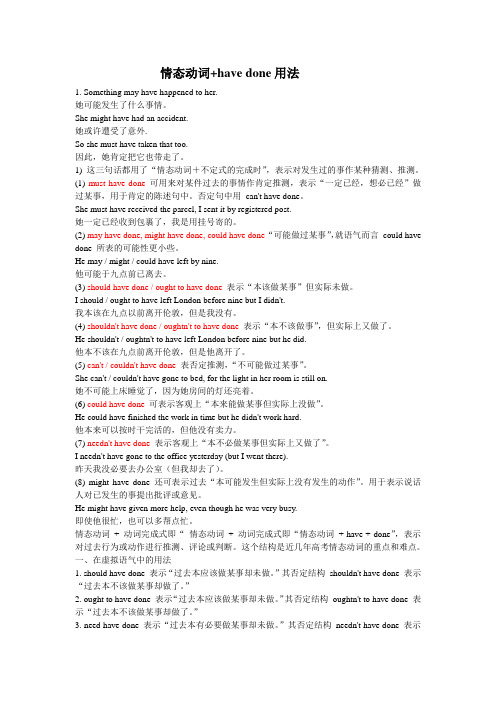
情态动词+have done用法1. Something may have happened to her.她可能发生了什么事情。
She might have had an accident.她或许遭受了意外.So she must have taken that too.因此,她肯定把它也带走了。
1) 这三句话都用了“情态动词+不定式的完成时”,表示对发生过的事作某种猜测、推测。
(1) must have done 可用来对某件过去的事情作肯定推测,表示“一定已经,想必已经”做过某事,用于肯定的陈述句中。
否定句中用can't have done。
She must have received the parcel, I sent it by registered post.她一定已经收到包裹了,我是用挂号寄的。
(2) may have done, might have done, could have done “可能做过某事”,就语气而言could have done 所表的可能性更小些。
He may / might / could have left by nine.他可能于九点前已离去。
(3) should have done / ought to have done表示“本该做某事”但实际未做。
I should / ought to have left London before nine but I didn't.我本该在九点以前离开伦敦,但是我没有。
(4) shouldn't have done / oughtn't to have done 表示“本不该做事”,但实际上又做了。
He shouldn't / oughtn't to have left London before nine but he did.他本不该在九点前离开伦敦,但是他离开了。
情态动词+完成时
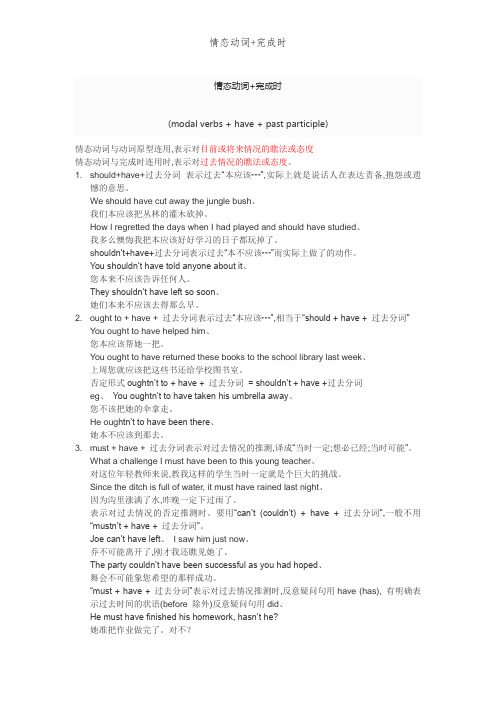
情态动词+完成时(modal verbs + have + past participle)情态动词与动词原型连用,表示对目前或将来情况的瞧法或态度情态动词与完成时连用时,表示对过去情况的瞧法或态度。
1. should+have+过去分词表示过去“本应该┅”,实际上就是说话人在表达责备,抱怨或遗憾的意思。
We should have cut away the jungle bush、我们本应该把丛林的灌木砍掉。
How I regretted the days when I had played and should have studied、我多么懊悔我把本应该好好学习的日子都玩掉了。
s houldn’t+have+过去分词表示过去“本不应该┅”而实际上做了的动作。
You shouldn’t have told anyone about it、您本来不应该告诉任何人。
They shouldn’t have left so soon、她们本来不应该去得那么早。
2. ought to + have + 过去分词表示过去“本应该┅”,相当于“should + have + 过去分词”You ought to have helped him、您本应该帮她一把。
You ought to have returned these books to the school library last week、上周您就应该把这些书还给学校图书室。
否定形式oughtn’t to + have + 过去分词= shouldn’t + have +过去分词eg、You oughtn’t to have taken his umbrella away、您不该把她的伞拿走。
He oug htn’t to have been there、她本不应该到那去。
3. must + have + 过去分词表示对过去情况的推测,译成“当时一定;想必已经;当时可能”。
情态动词完成时态的用法
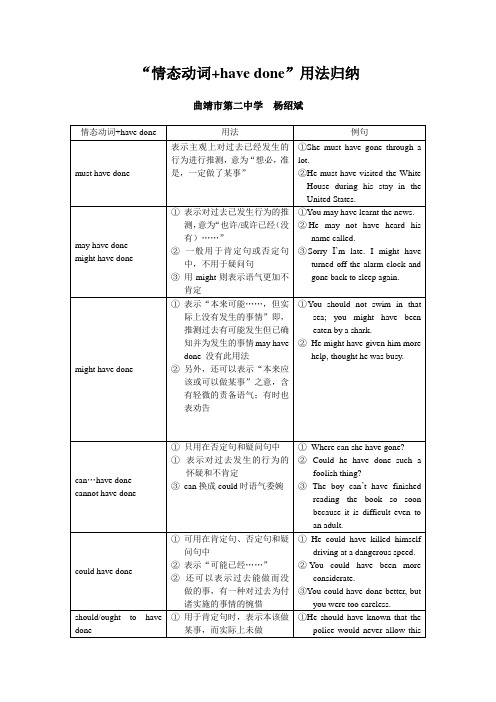
用于事后的建议,含轻微责备的口吻,意为“当时最好做了某事”,其否定式had better not have done表示相反的含义
①You had better have started earlier.
②You had better not havescoldedher.
can…have done
cannot have done
①只用在否定句和疑问句中
1表示对过去发生的行为的怀疑பைடு நூலகம்不肯定
③can换成could时语气委婉
①Where can she have gone?
②Could he have done such a foolish thing?
③The boy can’t have finished reading the book so soon because it is difficult even to an adult.
may have done
might have done
①表示对过去已发生行为的推测,意为“也许/或许已经(没有)……”
②一般用于肯定句或否定句中,不用于疑问句
③用might则表示语气更加不肯定
①You may have learnt the news.
②He may not have heard his name called.
②另外,还可以表示“本来应该或可以做某事”之意,含有轻微的责备语气;有时也表劝告
①You should notswimin that sea; you might have been eaten by a shark.
②He might have given him more help, thought he was busy.
情态动词完成时的用法
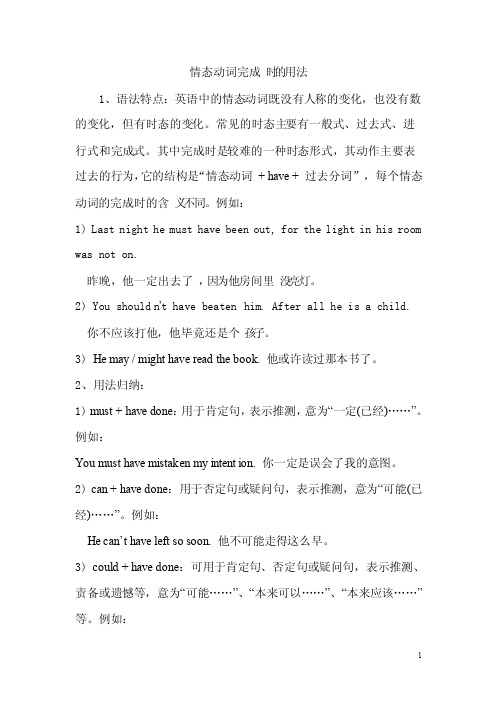
情态动词完成时的用法1、语法特点:英语中的情态动词既没有人称的变化,也没有数的变化,但有时态的变化。
常见的时态主要有一般式、过去式、进行式和完成式。
其中完成时是较难的一种时态形式,其动作主要表过去的行为,它的结构是“情态动词+ have + 过去分词”,每个情态动词的完成时的含义不同。
例如:1) Last night he must have been out, for the light in his room was not on.昨晚,他一定出去了,因为他房间里没亮灯。
2) You shouldn’t have beatenhim. After all he is a child. 你不应该打他,他毕竟还是个孩子。
3) He may / might have read the book. 他或许读过那本书了。
2、用法归纳:1) must + have done:用于肯定句,表示推测,意为“一定(已经)……”。
例如:You must have mistake n my intenti on. 你一定是误会了我的意图。
2) can + have done:用于否定句或疑问句,表示推测,意为“可能(已经)……”。
例如:Hecan’thaveleftsosoon.他不可能走得这么早。
3) could + have done:可用于肯定句、否定句或疑问句,表示推测、责备或遗憾等,意为“可能……”、“本来可以……”、“本来应该……”等。
例如:We could have walkedto the station , for it was so near .我们本来是可以走到车站去的,因为路很近。
4) should[ought to] + have done:可用于肯定句、否定句或疑问句,表示责备或遗憾等,意为“本来应该……”。
2022届高考英语二轮复习:“情态动词 完成时”的语法用法知识点总结(素材)
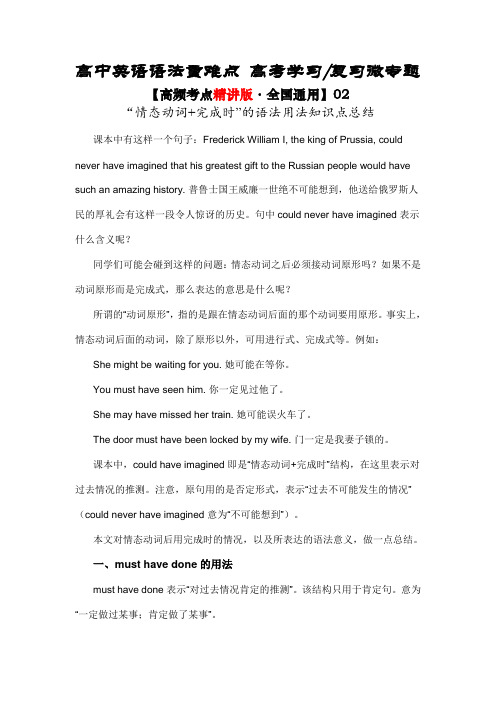
高中英语语法重难点高考学习/复习微专题【高频考点精讲版·全国通用】02“情态动词+完成时”的语法用法知识点总结课本中有这样一个句子:Frederick William I, the king of Prussia, could never have imagined that his greatest gift to the Russian people would have such an amazing history. 普鲁士国王威廉一世绝不可能想到,他送给俄罗斯人民的厚礼会有这样一段令人惊讶的历史。
句中could never have imagined表示什么含义呢?同学们可能会碰到这样的问题:情态动词之后必须接动词原形吗?如果不是动词原形而是完成式,那么表达的意思是什么呢?所谓的“动词原形”,指的是跟在情态动词后面的那个动词要用原形。
事实上,情态动词后面的动词,除了原形以外,可用进行式、完成式等。
例如:She might be waiting for you. 她可能在等你。
You must have seen him. 你一定见过他了。
She may have missed her train. 她可能误火车了。
The door must have been locked by my wife. 门一定是我妻子锁的。
课本中,could have imagined即是“情态动词+完成时”结构,在这里表示对过去情况的推测。
注意,原句用的是否定形式,表示“过去不可能发生的情况”(could never have imagined 意为“不可能想到”)。
本文对情态动词后用完成时的情况,以及所表达的语法意义,做一点总结。
一、must have done的用法must have done表示“对过去情况肯定的推测”。
该结构只用于肯定句。
意为“一定做过某事;肯定做了某事”。
Rosa must have attended the party last night.罗莎昨天晚上一定参加了晚会。
情态动词+have finished用法详解

情态动词+have finished用法详解情态动词+[have finished] 用法详解情态动词是英语中一类特殊的动词,用来表示说话人对某种行为或状态的态度、推测或能力等。
在与完成时态have finished搭配使用时,情态动词的意义会有进一步的延伸和强调。
本文将详细解释情态动词与have finished的用法。
1. "Can have finished"使用情态动词can与have finished搭配,可以表示过去某一时间点或者时间段内的完成行为。
它强调了完成的能力和可能性。
例如:- I can have finished the report by tomorrow. (明天之前,我可能已经完成了报告。
)- She can have finished her homework before dinner. (吃晚饭之前,她可能已经完成了作业。
)2. "Could have finished"情态动词could与have finished的结合,可以表示过去某一时间点或者时间段内本来能够完成,但实际上没有完成的情况。
它强调了对过去事实的揣测和推测。
例如:- He could have finished the project last week, but he got sick. (他上周本来能够完成这个项目,但他生病了。
)- They could have finished the race, but they had an accident. (他们本来能够完成比赛,但他们发生了事故。
)3. "May have finished"使用情态动词may与have finished连用,表示对过去事实的推测和猜测。
它强调了有可能已经完成的情况。
例如:- He may have finished his work before he left. (他可能在离开前已经完成了工作。
“情态动词+完成式”的用法

【导语】以下是⽆忧考整理的《“情态动词+完成式”的⽤法》,⼀起来看看吧!1)must + have done:⽤于肯定句,表⽰推测,意为“⼀定(已经)……”。
You must have finished the work. 你⼀定已经完成⼯作了。
2)can + have done:⽤于否定句或疑问句,表⽰推测,意为“可能(已经)……”。
He can’t have left so soon. 他不可能⾛得这么早。
3)could + have done:可⽤于肯定句、否定句或疑问句,表⽰推测、责备或遗憾等,意为“可能……”、“本来可以……”、“本来应该……”等。
You could have finished it, but you failed. 你本可以完成,但你失败了。
4)should [ought to] + have done:可⽤于肯定句、否定句或疑问句,表⽰责备或遗憾等,意为“本来应该……”。
You should have helped me, but you just sat and watched there.你本应该帮我的,但你只是在那坐着看。
5)need + have done:⽤于否定句或疑问句,⽤于否定时意为“本来不必”,⽤于疑问句时意为“有必要……吗”。
You needn’t have helped me because I could make it.你本没必要帮我的,我⾃⼰可以做到。
6)may + have done:⽤于肯定句或否定句,表⽰推测,意为“可能(已经)……”。
She may have seen this film. 她可能已经看过这部电影了。
7)might + have done:⽤于肯定句或否定句,表⽰推测,意为“可能(已经)……(此时might可换为 may);She may/ might have seen this film. 她可能已经看过这部电影了。
情态动词加现在完成时的用法
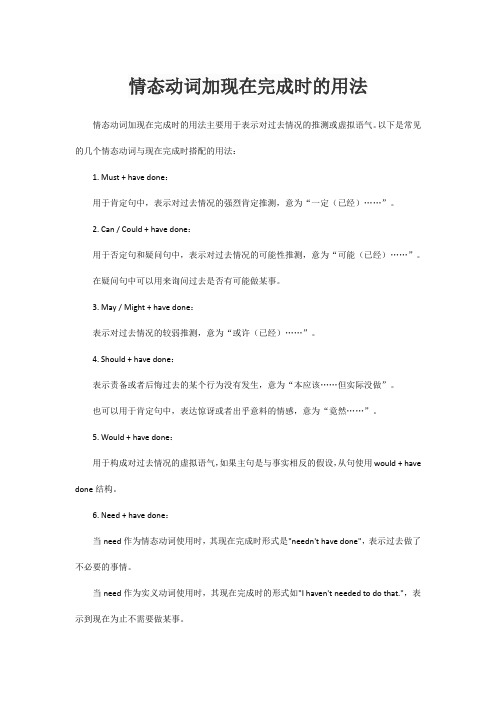
情态动词加现在完成时的用法情态动词加现在完成时的用法主要用于表示对过去情况的推测或虚拟语气。
以下是常见的几个情态动词与现在完成时搭配的用法:
1. Must + have done:
用于肯定句中,表示对过去情况的强烈肯定推测,意为“一定(已经)……”。
2. Can / Could + have done:
用于否定句和疑问句中,表示对过去情况的可能性推测,意为“可能(已经)……”。
在疑问句中可以用来询问过去是否有可能做某事。
3. May / Might + have done:
表示对过去情况的较弱推测,意为“或许(已经)……”。
4. Should + have done:
表示责备或者后悔过去的某个行为没有发生,意为“本应该……但实际没做”。
也可以用于肯定句中,表达惊讶或者出乎意料的情感,意为“竟然……”。
5. Would + have done:
用于构成对过去情况的虚拟语气,如果主句是与事实相反的假设,从句使用would + have done结构。
6. Need + have done:
当need作为情态动词使用时,其现在完成时形式是"needn't have done",表示过去做了不必要的事情。
当need作为实义动词使用时,其现在完成时的形式如"I haven't needed to do that.",表示到现在为止不需要做某事。
7. Used to + have done:
表示过去习惯性的动作,现在已经不再如此。
情态动词的现在完成式的用法你知道么?
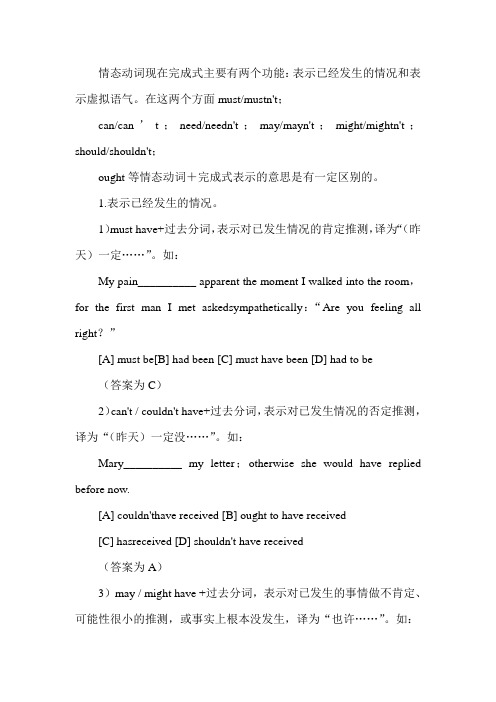
情态动词现在完成式主要有两个功能:表示已经发生的情况和表示虚拟语气。
在这两个方面must/mustn't;can/can’t;need/needn't;may/mayn't;might/mightn't;should/shouldn't;ought等情态动词+完成式表示的意思是有一定区别的。
1.表示已经发生的情况。
1)must have+过去分词,表示对已发生情况的肯定推测,译为“(昨天)一定……”。
如:My pain__________ apparent the moment I walked into the room,for the first man I met askedsympathetically:“Are you feeling all right?”[A] must be[B] had been [C] must have been [D] had to be(答案为C)2)can't / couldn't have+过去分词,表示对已发生情况的否定推测,译为“(昨天)一定没……”。
如:Mary__________ my letter;otherwise she would have replied before now.[A] couldn'thave received [B] ought to have received[C] hasreceived [D] shouldn't have received(答案为A)3)may / might have +过去分词,表示对已发生的事情做不肯定、可能性很小的推测,或事实上根本没发生,译为“也许……”。
如:At FloridaPower's Crystal River plant,apotentially serious leakage of radioactive water may have been unknowinglycaused by an electrician.2.表示虚拟语气。
23情态动词+完成时
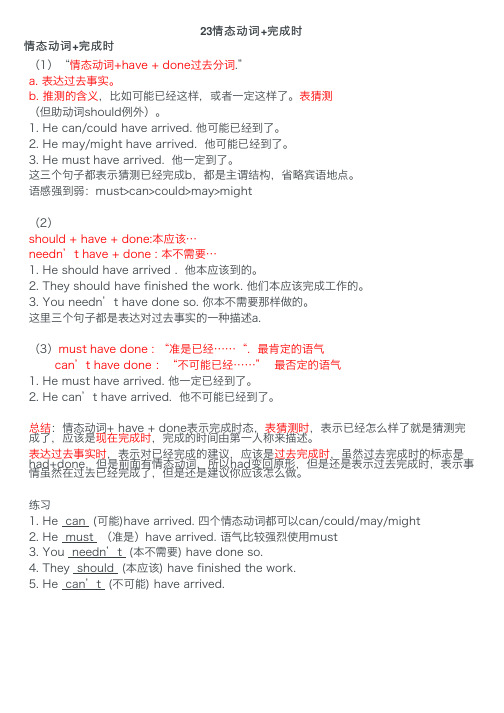
23情态动词+完成时情态动词+完成时(1)“情态动词+have + done过去分词.”a. 表达过去事实。
b. 推测的含义,⽐如可能已经这样,或者⼀定这样了。
表猜测(但助动词should例外)。
1. He can/could have arrived. 他可能已经到了。
2. He may/might have arrived. 他可能已经到了。
3. He must have arrived. 他⼀定到了。
这三个句⼦都表⽰猜测已经完成b,都是主谓结构,省略宾语地点。
语感强到弱:must>can>could>may>might(2)should + have + done:本应该…needn’t have + done : 本不需要…1. He should have arrived . 他本应该到的。
2. They should have finished the work. 他们本应该完成⼯作的。
3. You needn’t have done so. 你本不需要那样做的。
这⾥三个句⼦都是表达对过去事实的⼀种描述a.(3)must have done : “准是已经……“. 最肯定的语⽓can’t have done :“不可能已经……” 最否定的语⽓1. He must have arrived. 他⼀定已经到了。
2. He can’t have arrived. 他不可能已经到了。
总结:情态动词+ have + done表⽰完成时态,表猜测时,表⽰已经怎么样了就是猜测完成了,应该是现在完成时,完成的时间由第⼀⼈称来描述。
表达过去事实时,表⽰对已经完成的建议,应该是过去完成时,虽然过去完成时的标志是had+done,但是前⾯有情态动词,所以had变回原形,但是还是表⽰过去完成时,表⽰事情虽然在过去已经完成了,但是还是建议你应该怎么做。
练习1. He can (可能)have arrived. 四个情态动词都可以can/could/may/might2. He must (准是)have arrived. 语⽓⽐较强烈使⽤must3. You needn’t (本不需要) have done so.4. They should (本应该) have finished the work.5. He can’t (不可能) have arrived.。
情态动词英语语法知识点汇总
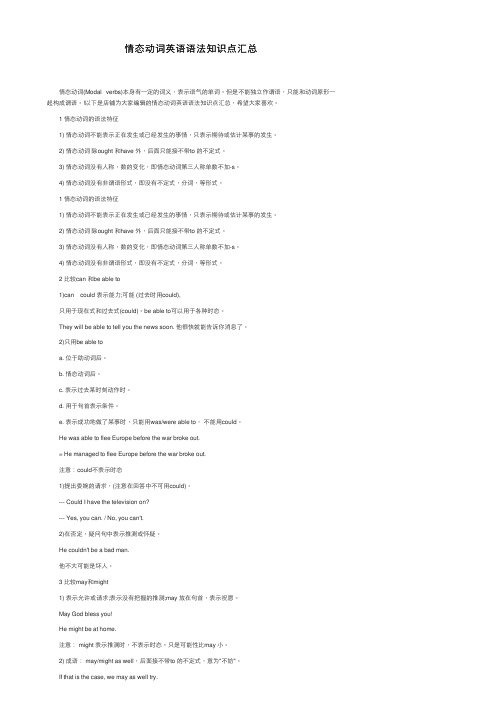
情态动词英语语法知识点汇总情态动词(Modal verbs)本⾝有⼀定的词义,表⽰语⽓的单词。
但是不能独⽴作谓语,只能和动词原形⼀起构成谓语。
!以下是店铺为⼤家编辑的情态动词英语语法知识点汇总,希望⼤家喜欢。
1 情态动词的语法特征1) 情态动词不能表⽰正在发⽣或已经发⽣的事情,只表⽰期待或估计某事的发⽣。
2) 情态动词除ought 和have 外,后⾯只能接不带to 的不定式。
3) 情态动词没有⼈称,数的变化,即情态动词第三⼈称单数不加-s。
4) 情态动词没有⾮谓语形式,即没有不定式,分词,等形式。
1 情态动词的语法特征1) 情态动词不能表⽰正在发⽣或已经发⽣的事情,只表⽰期待或估计某事的发⽣。
2) 情态动词除ought 和have 外,后⾯只能接不带to 的不定式。
3) 情态动词没有⼈称,数的变化,即情态动词第三⼈称单数不加-s。
4) 情态动词没有⾮谓语形式,即没有不定式,分词,等形式。
2 ⽐较can 和be able to1)can could 表⽰能⼒;可能 (过去时⽤could),只⽤于现在式和过去式(could)。
be able to可以⽤于各种时态。
They will be able to tell you the news soon. 他很快就能告诉你消息了。
2)只⽤be able toa. 位于助动词后。
b. 情态动词后。
c. 表⽰过去某时刻动作时。
d. ⽤于句⾸表⽰条件。
e. 表⽰成功地做了某事时,只能⽤was/were able to,不能⽤could。
He was able to flee Europe before the war broke out.= He managed to flee Europe before the war broke out.注意:could不表⽰时态1)提出委婉的请求,(注意在回答中不可⽤could)。
--- Could I have the television on?--- Yes, you can. / No, you can't.2)在否定,疑问句中表⽰推测或怀疑。
高中英语知识点大全(84):情态动词may、might +完成时

高中英语知识点大全(84):情态动词may/might +完成时1、manage vt. 经营;设法;对付She managed the house very well. 她把家管理得很好。
We managed to finish the work ahead of time. 我们设法提前完成了任务。
I shan’t be able to manage without help.没有人帮助,我无法办到。
[辨析] manage to do sth. /try to do sth.manage to do sth.意为“设法完成或做到某事”,强调已达到目的或出现了结果,含“成功”之意。
try to do sth. 意为“试图或尽力做某事”,多表示一种企图或决心,而不表示一定成功。
如:we’ve managed to make up for the lost time.我们设法把失去的时间补了回来。
He tried to pass the examination,but failed. 他努力想通过考试,但没成功。
He managed to organize a live concert. = He succeeded in organizing a live concert.他设法组织了一次现场直播的音乐会。
2、livelive by it 赖……为生;以……为生(不可用于被动语态)Live by(one’s)pen 以笔耕为生live through(it) 活过,度过……而不死(不可用于被动语态) live out 活着,熬过live…life过着……生活 live a hard life过着艰苦的生活 live a miserable life过着悲惨的生活live a happy life 过着愉快的生活 live a quiet life过着安静的生活Einstein lived the rest of his life quietly in the USA. 爱因斯坦在美国安静地度过了他的余生。
详述英语中的情态动词
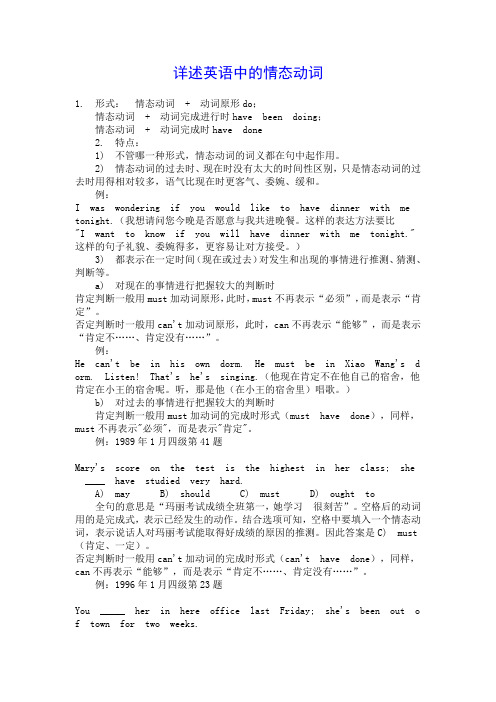
详述英语中的情态动词1. 形式:情态动词 + 动词原形do;情态动词 + 动词完成进行时have been doing;情态动词 + 动词完成时have done2. 特点:1) 不管哪一种形式,情态动词的词义都在句中起作用。
2) 情态动词的过去时、现在时没有太大的时间性区别,只是情态动词的过去时用得相对较多,语气比现在时更客气、委婉、缓和。
例:I was wondering if you would like to have dinner with me tonight.(我想请问您今晚是否愿意与我共进晚餐。
这样的表达方法要比"I want to know if you will have dinner with me tonight."这样的句子礼貌、委婉得多,更容易让对方接受。
)3) 都表示在一定时间(现在或过去)对发生和出现的事情进行推测、猜测、判断等。
a) 对现在的事情进行把握较大的判断时肯定判断一般用must加动词原形,此时,must不再表示“必须”,而是表示“肯定”。
否定判断时一般用can't加动词原形,此时,can不再表示“能够”,而是表示“肯定不……、肯定没有……”。
例:He can't be in his own dorm. He must be in Xiao Wang's dorm. Listen! That's he's singing.(他现在肯定不在他自己的宿舍,他肯定在小王的宿舍呢。
听,那是他(在小王的宿舍里)唱歌。
)b) 对过去的事情进行把握较大的判断时肯定判断一般用must加动词的完成时形式(must have done),同样,must 不再表示"必须",而是表示"肯定"。
例:1989年1月四级第41题Mary's score on the test is the highest in her class; she ____ have s tudied very hard.A) may B) should C) must D) ought to全句的意思是“玛丽考试成绩全班第一,她学习很刻苦”。
高考透析---情态动词的完成时

• 3. 做题时想象语言所描述的情景,确定使用何种 感情,进而决定用哪个情态动词。
Must + have + done
• 一、Must + have + done表示对过去发生的 事情或状态进行推测,语气比较坚定,通 常只用于肯定句。如: • It must have rained last night, for the ground is wet. • You must have been mad to speak to the servant.
作业巩固--直击高考
• 3. Just be patient. You ___ expect the world to change so soon. (2010) • A. can't B. needn't C. may not D. whether • 4. I __ use a clock to wake me up because at six o'clock each morning the train comes by my house. (2012) • A. couldn't B. mustn't • C.shouldn't D.needn't
• 作业巩固--直击高考 • 1. [考点]: should表示惊讶,惋惜之意的时 • 的用法。 • 根据but一词我们可以知道应用should,表 示一种惊讶,出乎意料之意。本题语义: 你去北湖玩儿的怎么样,北湖漂亮吧?北 湖应该漂亮,但现在污染的比较厉害。因 此本题选C。
• 2. [考点]: should+have+done的用法。 • should+have+done表示过去本应发生的事却 没有发生。 • 根据句意他们本应该午饭时到,但是航班 误点了。因此本题选D。
情态动词应注意的问题
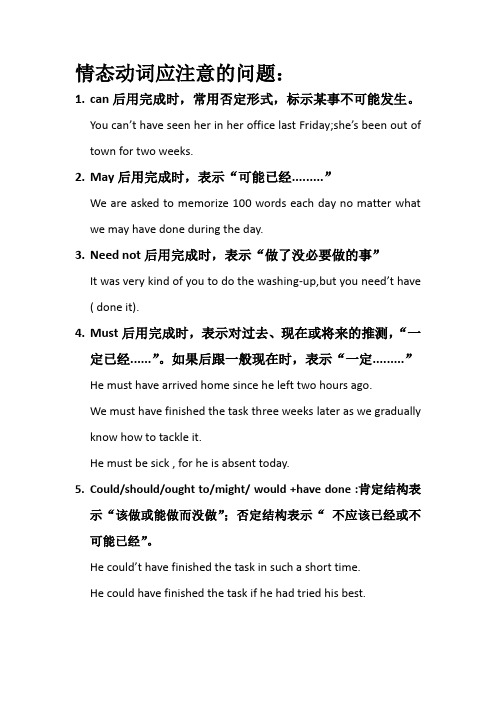
情态动词应注意的问题:1.can后用完成时,常用否定形式,标示某事不可能发生。
You can’t have seen her in her office last Friday;she’s been out of town for two weeks.2.May后用完成时,表示“可能已经.........”We are asked to memorize 100 words each day no matter what we may have done during the day.3.Need not后用完成时,表示“做了没必要做的事”It was very kind of you to do the washing-up,but you need’t have ( done it).4.Must后用完成时,表示对过去、现在或将来的推测,“一定已经......”。
如果后跟一般现在时,表示“一定.........”He must have arrived home since he left two hours ago.We must have finished the task three weeks later as we gradually know how to tackle it.He must be sick , for he is absent today.5.Could/should/ought to/might/ would +have done :肯定结构表示“该做或能做而没做”;否定结构表示“不应该已经或不可能已经”。
He could’t have finished the task in such a short time.He could have finished the task if he had tried his best.。
- 1、下载文档前请自行甄别文档内容的完整性,平台不提供额外的编辑、内容补充、找答案等附加服务。
- 2、"仅部分预览"的文档,不可在线预览部分如存在完整性等问题,可反馈申请退款(可完整预览的文档不适用该条件!)。
- 3、如文档侵犯您的权益,请联系客服反馈,我们会尽快为您处理(人工客服工作时间:9:00-18:30)。
“情态动词+完成时”是历年高考的热点,在做此类练习时,既需要掌握这一结构的基本用法,又应该仔细体会题干所提供的语言信息,准确理解语言环境和说话人的含义,尤其要注意题干中时态给予的暗示。
1. must have done 表示对已经发生的事情的推测,意为“一定,想必”。
这种结构一般只用于肯定句,其否定形式是can't (couldn't)have done ,表示“不可能,肯定不会”。
例如:
He didn't hear the phone. He must have be en asleep.
他没有听到电话响,他肯定是已经睡着了。
He must have been to Shanghai.
他一定去过上海。
They can't have gone out , because the ligh t is on .
他们不可能出去,因为灯亮着。
2. can(could)have done表示对过去的时间内可能发生的事情的猜测,can have done 一般只用于否定句和疑问句。
could have done 还可以用于肯定句,常用来表示本来可能完成而实际未完成的动作。
例如:
He can't have finished the work so soon.
这项工作他不可能完成得这样快。
We could have walked to the station , it wa s so near .
我们本来是可以走到车站去的,路很近。
3. may(might)have done 表示对已经发
生的事情的不太肯定的推测,意为“可能已经,或许已经”。
例如:
If we had taken the other road , we might h ave arrived earlier.
如果我们选择另一条路,我们可能会到得早一些。
He might have given you more help , he w as very busy .
他本来是可以给你更多帮助的,尽管他很忙。
4. needn”t have done 指实际上做了本来不必要做的事,意为“本来不必”。
例如:There was plenty of time . She needn”t hav e hurried.
时间很充裕,她本不必匆忙。
You needn”t have told him the news.
他本来不必把这个消息告诉他。
5. should (ought to )have done 指本该做而实际未做的事,意为“本来应该”。
其否定式shouldn”t(oughtn”t)have done 则表示某种行为不该发生但却发生了。
例如:
You should have started earlier , but you di dn”t.
你本应该早一点出发,但是你没有。
You ought to have helped him (but you d idn”t). 你本应该帮助他。
We shouldn”t have waited for her because she never came.
我们本不应该等她,因为她根本不会来。
